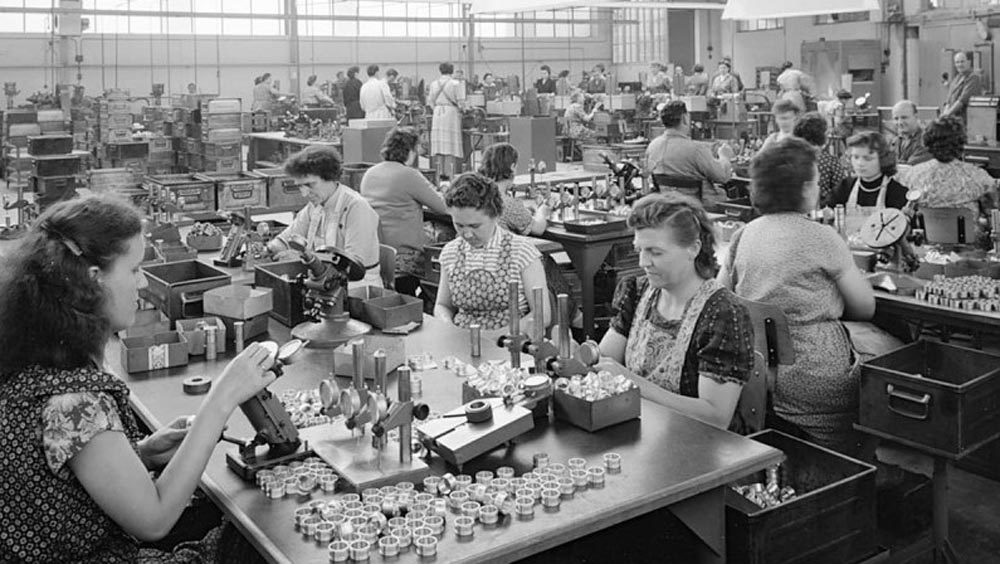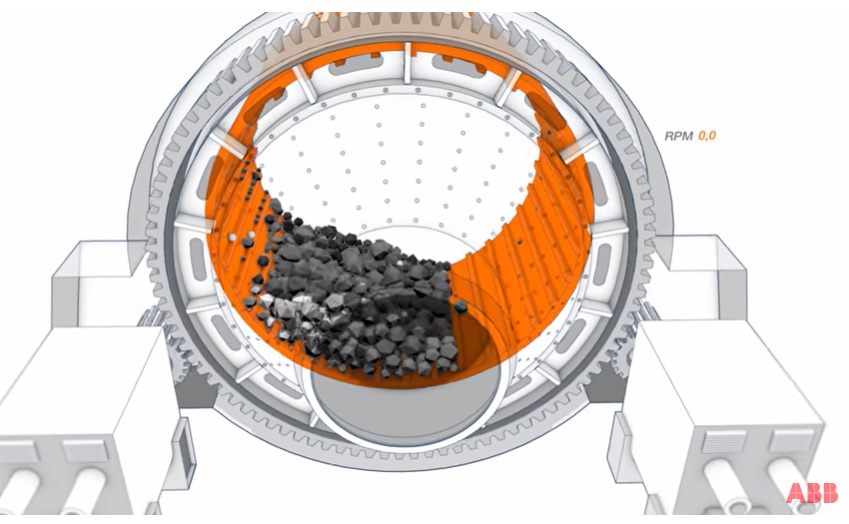An Automotive and Industrial Difference Maker
The Unique Story of Schaeffler’s Needle Roller Bearing Design
The company’s early quality controls, as shown in this photo of the assembly plant from the early 1950s. Courtesy of Schaeffler.
Dr.-Ing. E.h. Georg Schaeffler filed a patent for a component known as the cage-guided needle roller bearing (NRB) in 1950. A component offering a simple design, robust operation, and a very small design envelope that helped put Schaeffler on the map in the automotive and industrial markets. The company’s application expertise—from manual to automatic transmissions, followed later by e-mobility—evolved along with its NRB bearing technology.
History of the NRB
The lightest and smallest option in the roller bearing family is the NRB, according to Victoria Bigham, NRB product line manager at Schaeffler. They provide instant advantages for bearing applications that require reduced weight and space. A needle roller is defined as two end faces and a lateral surface with a length approximately 3–11 times larger than diameter.
“As we look at different bearing applications, everything, in my mind, is just a fancy NRB,” Bigham said. “When you get into ball bearings, cylindricals, tapers, you’re using that same roller cage/raceway combination in theory. So, our job is to go after a variety of different applications to determine how we can best use our bearing expertise to enhance these components for our customers.”
In 1950, Dr. Schaeffler filed a patent application for the caged NRB, shortly after founding the company, then known as Industrie GmbH, in 1946. The first practical tests involving cage-guided needle roller bearings began in February 1950. The results were convincing—the components exhibited extremely low wear and friction. The application for a patent in September 1950 laid the foundation for the product's success. In February 1951, just one year after construction of the first prototype, the first volume production orders were obtained from automotive manufacturers. Industrial applications soon followed.
“Schaeffler was the first to offer the separation between the rollers for large-scale production volumes,” Bigham added. “As the automotive industry was taking off, you were able to get the speed that you couldn’t get beforehand with a full complement roller bearing. The rise of the caged NRB essentially went together with the rise of the automotive industry.”
With his invention, Dr. Schaeffler eliminated the serious disadvantages associated with the full-complement needle roller bearings that had previously been used as standard: The long needle rollers tended to move in a transverse direction during rotation of the bearing (skewing), which would then cause the bearing to jam. Furthermore, a substantial amount of sliding friction was generated between the counter-rotating needle rollers.
Schaeffler’s development of the new needle cage overcame these disadvantages and permitted considerably higher speeds and less friction. This allowed engineers to substitute other bearing designs for cage-guided NRBs and significantly improve the performance of their applications. The use of needle roller bearings in mechanical and plant engineering, construction, and agricultural machinery, and in conveyor technology, was also being gradually introduced.
Evolution of the NRB
Needle rollers can be used in several different assemblies for different applications, including loose rollers, rollers, and cage assemblies, drawn cup, and machined products. How the bearing will be housed in an application will dictate whether a drawn cup, machined, or cage and roller assembly is needed.
Schaeffler developed -D- types that use longer needles within the same total bearing diameter; this increases load capacity and allows for load increases without design changes. Alternatively, you can achieve the same load with less space.
The D-XL series boasts an improved cage design that allows a higher number of needle rollers with higher load-carrying capacity, less friction and weight as well as reduced operating costs. D-XL bearings are part of Schaeffler’s X-life lineup of premium bearings, which optimizes the contact outer raceway’s contact surface for less friction, especially with plastic cages, and longer operating life.
As customers continued to pursue components for their high speed, light weight, low cost, and simplified fitting, the NRB continued to gain traction in areas like medical equipment, robotics, hand tools, and, of course, mobility solutions such as e-bikes.
“To this day, we’re working with a hand tool manufacturer that was using a plain bearing and they switched it to an NRB for the speed and load advantages, as well as a more compact design,” Bigham said. “Frictional benefits improve the longevity of the component but also potentially provide less friction for the overall system.”

In 1950, Dr. Schaeffler filed a patent application for the caged NRB, shortly after founding the company, then known as Industrie GmbH, in 1946.
Automatic transmissions, which often have several NRB positions, use the cage and roller assemblies, thrust bearings, drawn cup and machined-type NRBs.
In the planetary train, cage and roller assemblies are used for the planets with the inner raceway directly on the planet pin, while the outer raceway functions as the planet pinion’s bore, where it supports high rotational speeds and centrifugal forces.
In addition, Schaeffler offers KZK- and KBK-type NRBs specifically for crank and piston pins.
Needle roller and cage assemblies for connecting rod bearing arrangements are used in the crank mechanisms of two- and four-stroke engines as well as in compressors for supporting crank pins and piston pins. Consisting of cages equipped with needle rollers, they support high centrifugal and acceleration forces and are suitable for high speeds.
They require very little radial space since the radial section height only corresponds to the diameter of the needle rollers. They give bearing arrangements high runout accuracy which is, however, influenced by the geometrical accuracy of the raceways. The radial internal clearance is dependent on the needle sort as well as the shaft and housing tolerances and can be adjusted by means of the needle roller sort.
Needle roller and cage assemblies for crank pins (i.e., KZK NRBs) are externally guided, which means that the connecting rod bore guides the cage radially with defined clearance. The radial movement of the cage in relation to the connecting rod bore and the rolling elements is as small as possible.
The cages are made from quenched and tempered steel, have good wear resistance, exhibit high strength and their large guidance surfaces are designed for optimum lubrication.
Needle roller and cage assemblies for piston pins (i.e., KBK NRBs) are internally guided, which means that the piston pin guides the cage radially with defined clearance. Due to their small radial internal clearance, tilting of the connecting rod is reduced to a minimum. The needle roller and cage assemblies support high frequency oscillating loads and are available for most piston pin diameters in various widths, in accordance with the piston boss spacing. The steel cages are case hardened or quenched and tempered, exhibit good wear resistance, and have high strength.
Drawn cup roller clutches are one-way clutches comprising thin-walled outer rings, cage, and needle rollers. Drawn cup roller clutches can be used in a wide range of applications such as shifting elements, back-stopping clutches, overrunning clutches, or any highly dynamic application that needs an increased power density or reduced shift angle. In terms of components utilized in e-mobility applications, they also offer increased ride comfort—a necessity as the e-bike drivetrain continues to evolve each year.


As customers continued to pursue components for their high speed, light weight, low cost, and simplified fitting, the NRB continued to gain traction in areas like medical equipment, robotics, hand tools, and, of course, mobility solutions such as e-bikes.
An Electric Future
Needle roller bearings will continue to play a key role in the future. In e-mobility, needle roller bearings are vital for the function of numerous electrified transmissions. Needle roller and cage assemblies facilitate bearing arrangements with a minimal design envelope, since their section height only corresponds to the diameter of the needle rollers. In addition, they have a high load-carrying capacity and are inexpensive compared with other bearing designs. KZK needle roller bearings (crank pin cages) are used, for example, in e-axles with a coaxial design.
One application example is the Schaeffler e-axle drive, which has been produced for Audi’s e-tron brand of electric and hybrid-electric vehicles since 2018. In the Audi e-tron, Schaeffler electric axle transmissions, with different structural designs, are used on both axles for all-wheel drive capability. Meanwhile, Porsche’s all-electric Taycan sports sedan is fitted with a high-efficiency Schaeffler coaxial electric axle transmission to provide the required transmission ratio on the front axle.
In 2020, the coaxial electric axle transmission earned Schaeffler the prestigious PACE Award, regarded by the industry worldwide as the hallmark for successful automotive projects. Schaeffler has also secured multiple orders for its complete “3-in-1 electric axles,” which combine the electric motor, drive unit and power electronics in a single system. These are high-performance electric axles with advanced power density.
Over the last few years, Schaeffler has progressively strengthened its electric mobility expertise through a series of targeted acquisitions. The purchase of Elmotec Statomat at the end of 2018 added new expertise in winding technology, providing Schaeffler with comprehensive coverage of all aspects of electric motor industrialization. Another highly successful addition to the Schaeffler Group back in 2016 was the acquisition of Compact Dynamics, a specialist in the development of innovative electric drive concepts. Meanwhile, the Schaeffler Paravan Technologie joint venture is developing its proprietary Space Drive steer-by-wire system, a key technology for autonomous driving.
Schaeffler supplies technologies for all electrified drivetrains. Mass production of the electric axle transmission, a key component of electric axle systems, has been running successfully since 2017, providing optimum transmission ratios and power transfer from the electric motor to the wheels. This is a highly versatile component with a wide range of applications.

On the industrial side, where lightweight robots are increasingly in demand, the use of needle bearings permits light and compact joint designs by means of downsizing.
On the industrial side, where lightweight robots are increasingly in demand, the use of needle bearings permits light and compact joint designs by means of downsizing. The needle bearings provide minimal variability and the highest level of safety. The most recent example is Schaeffler’s XZU angular contact needle roller bearing, which is used both as an articulated arm bearing in lightweight robots and cobots, and as the main bearing arrangement in the company’s new RTWH precision gearbox, a ready-to-install reduction gear unit for robot joints.
In the development of electric powertrain components, Schaeffler benefits from the experience the company has gained in conventional powertrains with IC engines, for instance in digital simulation. The know-how from the development of starting elements like the torque converter or the double-clutch broadens the development and manufacturing expertise available at Schaeffler.
“We have successfully transformed ourselves into a drive system supplier for sustainable electric mobility solutions and established ourselves as a reliable partner for our customers,” says Matthias Zink, CEO Automotive Technologies at Schaeffler AG. Schaeffler’s key point of difference is its know-how on components and system levels. “We have been engaged with electric mobility for more than 20 years and we understand the drive train requirements. Our innovation capacity as a global automotive and industrial supplier plus our strong industrial skills make us a preferred partner for our customers.”
And to think this evolution began with a very simple, yet extremely reliable bearing design concept. 







